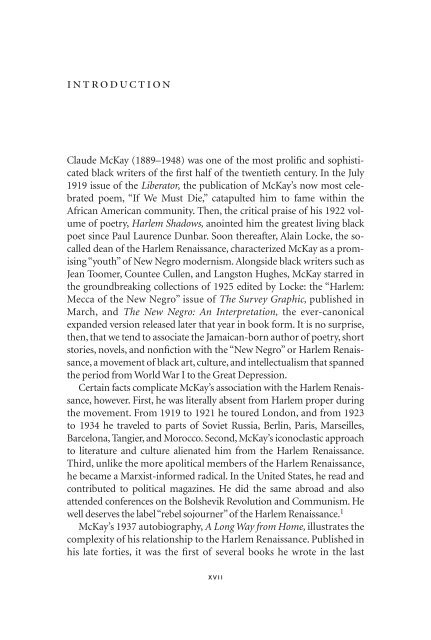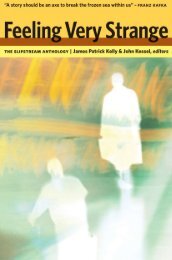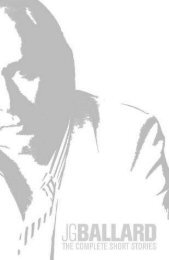- Page 1: a long way from Home
- Page 5 and 6: a long way from Home Claude McKay e
- Page 7: contents Acknowledgments ix Chronol
- Page 11 and 12: chronology 1889 Festus Claudius McK
- Page 13 and 14: chronology • xiii 1924 Completes
- Page 15: chronology • xv impoverished and
- Page 19 and 20: introduction • xix emphasizing ce
- Page 21 and 22: introduction • xxi mobility: “I
- Page 23 and 24: introduction • xxiii A Long Way f
- Page 25 and 26: introduction • xxv art” and ins
- Page 27 and 28: introduction • xxvii grasp why in
- Page 29 and 30: introduction • xxix Despite his v
- Page 31 and 32: introduction • xxxi lished a volu
- Page 33 and 34: introduction • xxxiii had once an
- Page 35 and 36: introduction • xxxv Notes 1. I bo
- Page 37: introduction • xxxvii accent mark
- Page 41: a long way from Home
- Page 45 and 46: contents part one: american beginni
- Page 47: part one American Beginning
- Page 50 and 51: 10 • a long way from home its mig
- Page 52 and 53: 12 • a long way from home picked
- Page 54 and 55: 14 • a long way from home memory.
- Page 56 and 57: 16 • a long way from home After a
- Page 58 and 59: 18 • a long way from home world c
- Page 60 and 61: 20 • a long way from home across
- Page 62 and 63: 22 • a long way from home You mus
- Page 64 and 65: 24 • a long way from home Suddenl
- Page 66 and 67:
chapter 2 Other Editors It was a gr
- Page 68 and 69:
28 • a long way from home could n
- Page 70 and 71:
30 • a long way from home city to
- Page 72 and 73:
32 • a long way from home only, a
- Page 74 and 75:
34 • a long way from home distinc
- Page 76 and 77:
36 • a long way from home Mr. Gra
- Page 78 and 79:
38 • a long way from home for one
- Page 80 and 81:
chapter 4 Another White Friend Ihad
- Page 82 and 83:
42 • a long way from home And the
- Page 84 and 85:
44 • a long way from home drank t
- Page 86 and 87:
46 • a long way from home “Well
- Page 88 and 89:
48 • a long way from home been wi
- Page 91 and 92:
chapter 5 Adventuring in Search of
- Page 93 and 94:
adventuring in search of george ber
- Page 95 and 96:
adventuring in search of george ber
- Page 97 and 98:
pugilist vs. poet • 57 that was w
- Page 99 and 100:
pugilist vs. poet • 59 I was the
- Page 101 and 102:
chapter 7 A Job in London Yet Londo
- Page 103 and 104:
a job in london • 63 bury did not
- Page 105 and 106:
a job in london • 65 and who were
- Page 107 and 108:
a job in london • 67 infertile so
- Page 109 and 110:
a job in london • 69 ital had bee
- Page 111 and 112:
chapter 8 Regarding Reactionary Cri
- Page 113 and 114:
egarding reactionary criticism •
- Page 115:
egarding reactionary criticism •
- Page 119 and 120:
chapter 9 Back in Harlem Like fixed
- Page 121 and 122:
ack in harlem • 81 The times were
- Page 123 and 124:
ack in harlem • 83 noble and genu
- Page 125 and 126:
ack in harlem • 85 particularly e
- Page 127 and 128:
ack in harlem • 87 fortune when h
- Page 129 and 130:
ack in harlem • 89 “He isn’t
- Page 131 and 132:
ack in harlem • 91 Walter White a
- Page 133 and 134:
ack in harlem • 93 with Du Bois l
- Page 135 and 136:
a brown dove cooing • 95 features
- Page 137 and 138:
a brown dove cooing • 97 and runn
- Page 139 and 140:
a look at h. g. wells • 99 spear.
- Page 141 and 142:
a look at h. g. wells • 101 monke
- Page 143 and 144:
a look at h. g. wells • 103 Also,
- Page 145 and 146:
“he who gets slapped” • 105 O
- Page 147 and 148:
“he who gets slapped” • 107 a
- Page 149 and 150:
The White House Your door is shut a
- Page 151 and 152:
“he who gets slapped” • 111 a
- Page 153 and 154:
“he who gets slapped” • 113 m
- Page 155 and 156:
“he who gets slapped” • 115 A
- Page 157 and 158:
“harlem shadows” • 117 Compan
- Page 159:
part four The Magic Pilgrimage
- Page 162 and 163:
122 • a long way from home go wit
- Page 164 and 165:
I received back my passport and Cry
- Page 166 and 167:
126 • a long way from home Americ
- Page 168 and 169:
128 • a long way from home in a s
- Page 170 and 171:
130 • a long way from home first
- Page 172 and 173:
132 • a long way from home Never
- Page 174 and 175:
134 • a long way from home me now
- Page 176 and 177:
136 • a long way from home Americ
- Page 178 and 179:
138 • a long way from home and im
- Page 180 and 181:
140 • a long way from home I thin
- Page 182 and 183:
142 • a long way from home eyes w
- Page 184 and 185:
chapter 17 Literary Interest The Co
- Page 186 and 187:
146 • a long way from home kindly
- Page 188 and 189:
148 • a long way from home and pe
- Page 190 and 191:
150 • a long way from home The Mo
- Page 192 and 193:
152 • a long way from home lips w
- Page 194 and 195:
154 • a long way from home althou
- Page 196 and 197:
156 • a long way from home there
- Page 198 and 199:
158 • a long way from home dresse
- Page 200 and 201:
160 • a long way from home was St
- Page 202 and 203:
162 • a long way from home Valenc
- Page 204 and 205:
164 • a long way from home prepar
- Page 206 and 207:
166 • a long way from home So I w
- Page 208 and 209:
168 • a long way from home admire
- Page 210 and 211:
170 • a long way from home furthe
- Page 212 and 213:
The poem was published in the Petro
- Page 214 and 215:
chapter 20 Regarding Radical Critic
- Page 216 and 217:
176 • a long way from home I crea
- Page 218 and 219:
was cocked stiff to one side like a
- Page 220 and 221:
180 • a long way from home Circli
- Page 223 and 224:
chapter 21 Berlin and Paris At last
- Page 225 and 226:
erlin and paris • 185 were not as
- Page 227 and 228:
erlin and paris • 187 had had dif
- Page 229 and 230:
erlin and paris • 189 country, th
- Page 231 and 232:
erlin and paris • 191 Some of my
- Page 233 and 234:
erlin and paris • 193 literary ra
- Page 235 and 236:
chapter 22 Friends in France Ihad b
- Page 237 and 238:
friends in france • 197 all three
- Page 239 and 240:
friends in france • 199 There was
- Page 241 and 242:
friends in france • 201 telling h
- Page 243 and 244:
friends in france • 203 the Breto
- Page 245 and 246:
frank harris in france • 205 your
- Page 247 and 248:
frank harris in france • 207 pagn
- Page 249 and 250:
chapter 24 Cinema Studio Ihad visit
- Page 251 and 252:
cinema studio • 211 besieged me t
- Page 253 and 254:
chapter 25 Marseilles Motley It was
- Page 255 and 256:
marseilles motley • 215 Said the
- Page 257 and 258:
marseilles motley • 217 I went to
- Page 259 and 260:
marseilles motley • 219 painter.
- Page 261 and 262:
marseilles motley • 221 was no do
- Page 263:
marseilles motley • 223 promenade
- Page 267 and 268:
chapter 26 When a Negro Goes Native
- Page 269 and 270:
when a negro goes native • 229 we
- Page 271 and 272:
when a negro goes native • 231 A
- Page 273 and 274:
when a negro goes native • 233 Th
- Page 275 and 276:
chapter 27 The New Negro in Paris I
- Page 277 and 278:
the new negro in paris • 237 merg
- Page 279 and 280:
the new negro in paris • 239 Dear
- Page 281 and 282:
the new negro in paris • 241 call
- Page 283 and 284:
the new negro in paris • 243 The
- Page 285 and 286:
the new negro in paris • 245 My a
- Page 287 and 288:
the new negro in paris • 247 Also
- Page 289 and 290:
I heeded the warning. I started off
- Page 291 and 292:
hail and farewell to morocco • 25
- Page 293 and 294:
hail and farewell to morocco • 25
- Page 295 and 296:
hail and farewell to morocco • 25
- Page 297 and 298:
hail and farewell to morocco • 25
- Page 299 and 300:
Oh native colors, Pure colors aglow
- Page 301 and 302:
chapter 29 On Belonging to a Minori
- Page 303 and 304:
on belonging to a minority group
- Page 305 and 306:
on belonging to a minority group
- Page 307 and 308:
on belonging to a minority group
- Page 309 and 310:
on belonging to a minority group
- Page 311:
about the editor Gene Andrew Jarret





